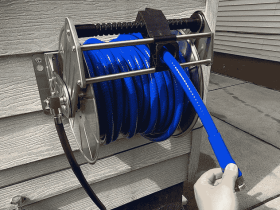Looking up at the ceiling fan spinning around can be almost hypnotic! But beyond looking pretty, ceiling fans serve an important purpose – circulating the air in a room. There’s nothing worse than feeling stuffy and stagnant when there’s no airflow. Having the right size ceiling fan for your room’s dimensions is important to get that refreshing breeze.
Whether you’re outfitting a bedroom, living room, office, or other space, how do you know what size ceiling fan to get? I know you are probably bothered about how to choose a ceiling fan or the size you should buy for your room’s layout! Well, fret no more.
In this helpful guide, I’ll walk you through how to determine the perfect ceiling fan size based on the length, width, and ceiling height of your space. I’ll provide tips and recommendations for typical room sizes and shapes. Read on for insights to ensure you get the ideal ceiling fan for your square footage!
Ceiling Fan Sizes for Different Room Dimensions
What Size Ceiling Fan for a 10×10 Room?
A small 10×10 foot room equates to 100 square feet. A 36 to 42-inch ceiling fan is a suitable choice for most standard 10×10-foot rooms. A fan diameter of the smaller size is required so the fan doesn’t overwhelm the space.
Look for fans around 38 inches for rooms with typical height ceilings between 8 and 9 feet. Go up to 42 inches for 10×10 rooms with extra high ceilings over 9 feet. The added blade length helps circulate air to the corners of rooms with cathedral or vaulted ceilings. Install the fan centrally in the middle of the room for optimal air circulation.
What Size Ceiling Fan for a 10×12 Room?
Moving up slightly in size, a 10×12-foot rectangular room has a total of 120 square feet. A fan with a blade span of 42-44 inches would work well with a standard 8-foot ceiling. This will produce sufficient airflow without being too large and overpowering for the space.
However, you can bump up to 46 inches if your room has higher 9 to 10-foot ceilings. Position the fan centrally on the ceiling between the 10 and 12-foot walls for efficient air distribution to the entire space.
This range hits the sweet spot of moving enough air for cooling and ventilation without excessive power.
What Size Ceiling Fan for a 12×12 Room?
For a medium 12×12 foot room with an area of 144 square feet, a good ceiling fan size option of 36 to 50 inches in blade span. A fan in this blade span range will produce enough airflow to cool and circulate air without being overpowering. So, specific models around 48 inches in diameter will be ideal for a standard 12×12 bedroom or other square foot room.
When installing a ceiling fan in a 12×12 room, also consider the height of the ceiling itself. Rooms with higher ceilings often need a larger fan than rooms with standard 8-foot ceilings for the fan to be efficient. Opt for a fan closer to 50 inches for 12×12 rooms with 9-foot or higher ceilings. This extra blade span compensates for the additional vertical space that the fan needs to circulate air to.
What Size Ceiling Fan for a 12×14 Room?
Now we get to a larger room size—the 12×14 foot room with an area of 168 square feet. Here, a ceiling fan size range of 42 to 54 inches is most suitable. A fan blade span in this range provides enough cooling power to properly circulate air throughout the moderately sized room.
However, looking for a fan around 52 inches is advisable if your 12×14 room has a typical 8 to 9-foot ceiling height. For taller ceilings, choose a slightly bigger 54-inch fan to ensure full coverage. Make sure the fan is centered on the ceiling for optimal airflow from corner to corner.
What Size Ceiling Fan for a Large Room?
Extra large rooms require proportionally bigger ceiling fans to distribute air effectively. According to Hunter’s reports on ‘’how to choose a ceiling fan,’’ 56 inches or larger ceiling fan blade spans are suitable for great rooms over 400 square feet. Oversized fans like this are necessary for ample air circulation in big open spaces. In large living rooms, family rooms, and other sizable spaces, a 72-inch ceiling fan is a good place to start. However, you can bump up to 80 inches for rooms with dramatic two-story ceilings. Position the fan centrally and make sure it is hung high enough not to obstruct walking paths or furnishings below.
So, if you need large ceiling fans from a reputable brand like Hunter Fan or other companies, just search on Google/Bing with the search term “The best Large ceiling fan”. You will find a lot of options where you can find the best one that is suitable for you.
What Things to Consider When Choosing a Ceiling Fan Size?
While matching your ceiling fan to the right room size is key, there are a few other factors to keep in mind as well when selecting a model:
- Ceiling fan location – When possible, choose a ceiling fan size based on the size of the area where it will be located rather than the overall room square footage. For instance, in living rooms, the fan is often placed over lounge spaces and not dining areas.
- Blade pitch – Higher angled blades move more air. Look for ceiling fans with a 14-degree blade pitch or more for optimal airflow.
- Multiple fans – For very large rooms, installing multiple smaller ceiling fans can provide better overall air distribution than one massive fan.
- Downrod lengths – Longer downrod lengths of 6 inches or more help move air better for high or vaulted ceilings.
Most importantly, always look for the ENERGY STAR label. Products that are recognized as ENERGY STAR Most Efficient deliver cutting-edge energy efficiency along with the latest in technological innovation. They represent the very best for energy savings and environmental protection.
Bottom Line
There you have it – a lot of information about ceiling fan sizes! I hope mapping out the recommended blade spans for typical room dimensions has helped simplify your buying decision. The bottom line is taking precise measurements of your ceiling height and square footage to choose a properly sized fan. This will optimize air circulation – no more stuffiness! With these handy tips in mind, you can shop for a ceiling fan that will keep the air flowing just right in your particular space.










Leave a Review